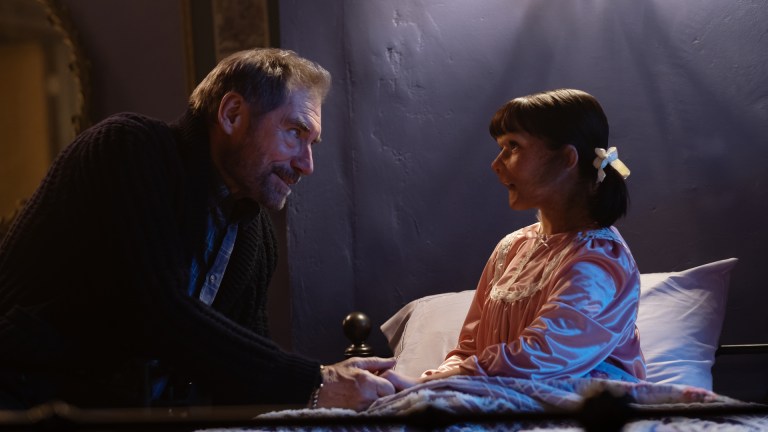Doom Patrol Season 2 and the Start of Something Big
Doom Patrol showrunner Jeremy Carver discusses the show's big plans for season 2 and how the "World's Strangest Heroes" can become more human.

Jeremy Carver has big things planned for Doom Patrol season 2. Literally.
The first season of the DC Universe series about super powered, and always bickering, misfits ended with most of the team shrunk to action-figure size. With the sophomore outing of the series debuting June 25, executive producer and showrunner Carver thinks it’s time for the characters to grow: physically and emotionally.
Along with waging war against near-omnipotent villain Mr. Nobody, as well as an apocalyptic cockroach, the team of outsider superheroes fought their internal demons, and one another, in a season that was comedic, surprisingly poignant, and delightfully bizarre.
Bizarre is part of the Doom Patrol DNA. Based on the DC comic created in 1963 by writers Arnold Drake, and Bob Haney, and artist Bruno Premiani, the book about Robotman, Negative Man, and Elasti-Girl took an even more eccentric direction when writer Grant Morrison took over in 1989. Morrison’s run — with the introduction of characters such as Crazy Jane, and Danny The Street – heavily influences the tone of the series. Yet the show, which will stream on HBO Max in addition to its native DC Universe this year, also expands the depths of the comic characters, most notably with the arc of Negative Man/Larry Trainor (played by both Matt Bomer and Matthew Zuk), who struggles with his identity as a gay man, and as a vessel for a sentient alien entity.
For season two, the Doom Patrol world also gets a little bigger. After learning the events that turned them into “freaks” were orchestrated by The Chief (Timothy Dalton) as a failed experiment to preserve his own life (to live long enough to protect his ageless daughter) the team is resentful towards their leader. Cliff Steele/Robotman (played by Brendan Fraser and Riley Shanahan) is especially enraged since the car crash that robbed him of his human form also led to his own daughter believing him to be dead for 30 years.
Plus, The Chief’s daughter, Dorothy Spinner (Abigail Shapiro) arrives with an innocent attitude and the immense power to conjure imaginary friends, who aren’t so friendly, and may have an apocalypse on their minds. One such character is The Candlemaker, who is teased in the season two trailer, along with other antagonists Dr. Tyme and Red Jack.
In the following interview, Carver discusses the direction of the new season, how much trauma is too much for characters (and viewers), and why the weird world of Doom Patrol isn’t all that weird for him.
DEN OF GEEK: How would you set up the overall theme of this season?
JEREMY CARVER: “The bloom is off Chief, and there’s the realization that he was responsible for their traumas. So when the head of the family is revealed to be a fraud, it brings into focus the idea that it’s time for the folks on this team to grow up. They’ve got to get big. That’s one of the reasons we start with them being small in the first episode. But that’s an idea that arcs over the entire season. We all have to finally deal with our shit, have to mature, and try to find a way past these traumas weighing us down.”
The characters experienced a lot in the first season confronting their tragic origins. But now we have Larry thinking about the children he left behind, and Vic confronting PTSD. What’s the balance between giving characters more trauma to experience but avoiding repetition? How do you keep trauma fresh?
One of the advantages of the situations our characters find themselves in is that so much time has passed. They are not 20-somethings. These aren’t Peter Parkers, as it were. They have a lot of history, before the accident, and after. When we introduce a character like Dorothy, who becomes something of a surrogate daughter to the group this season, it naturally follows each of them – in trying to grow up – is confronting their own traumas as kids, from their parents, or when they were parents themselves. And we work very carefully to make sure there is a balance in every story we’re telling, from the profane, to absurd, to deeply affecting, to the deeply traumatizing. Balance is something we’re always aware of.
For season two, and with Dorothy in particular, how closely are you hewing to the comic book arcs?
When it comes to Dorothy, one of the principle ways we’ve adjusted her character to fit the television version is the explanation that her parents were The Chief and Slava, the [primitive woman] he fell in love with in 1913 or so. That was the most significant change from the comics. With that change, it’s natural her overall arc would adjust as well. We do pay homage to many of the imaginary friends she made in the comics.
In the first season, Alan Tudyk as Mr. Nobody literally set up this world, and was the main big bad. Heading into the second season, did you look at a series of villains, or is there one overarching foe?
There are plenty of bads in season two. The ultimate big bad isn’t going to be what people think it is. That’s thematically related to the idea of maturity and growing. That will become a lot more apparent as the season goes on. We have a lot of wonderful new characters on the show this year – not the least of which is Dorothy played by Abigail Shapiro, and she takes over! She is absolutely amazing, and for all of us, the things Mr. Nobody season one, Dorothy is hitting a completely different part of the brain, and we all embrace that.
Between Candlemaker, Dr. Tyme, and Red Jack, who are you most excited about for audiences to see, and which was your favorite to bring to life?
Our super suits team did a wonderful job with Dr. Tyme, with a totally practical headpiece. I am proud of the whole group effort when it came to Red Jack, and the things that happen in his palace. The VFX work is nothing short of extraordinary. As a VFX geek, that was something to geek out about. And there is even crazier stuff coming down the line.
There was the cameo of the Doom Patrol in the Arrowverse/CW Crisis on Infinite Earths. Are you going to be leaning more into this connected universe?
The important thing in Crisis was to establish all these shows are part of a multiverse. As for anything more specific, there are no immediate plans.
The show was lauded for its LGBTQ+ representation, and by bringing to life a character such as the sentient street Danny The Street. How did that positive reaction inform the second season?
Danny was a character created roughly 30 years ago. We just brought Danny to life on TV. It is wonderful people can have such a positive reaction to them, but it’s also amazing it has taken this long to get that representation out to people. It was simply amazing to see how people reacted, and how the show spoke to them. I think one of the reasons we got a nice reaction was we tried to be as honest as possible. While some of our characters were being extremely honest, they weren’t always extremely polite. Because the writers were able to keep the characters real, and genuine. But you almost have to push that reaction aside to forge new ground.
What’s your reaction when people call this show weird, and how has it been weird for you?
I am so neck deep with these characters, and their emotions. So when I read people saying, “This is a deeply weird show,” I’m at the point where I don’t get what’s so weird about it. They are family to me now, and I’m like, “Why are you calling my family weird?” It takes me back to the pilot when we were shooting the first scene with Cliff and Larry outside having a conversation. I was like, “Holy shit, we did three minutes of no facial movement at all with this conversation.” And we didn’t record a final pass of the dialogue until after we were well into editing. So we didn’t know what we had exactly. That was one of the biggest leaps we took. The takeaway was, as scary as it can be, what people care about most is the right thing. The right thing is character. If you give a street, or brick, an interesting character, people embrace it. At least our fans do.
